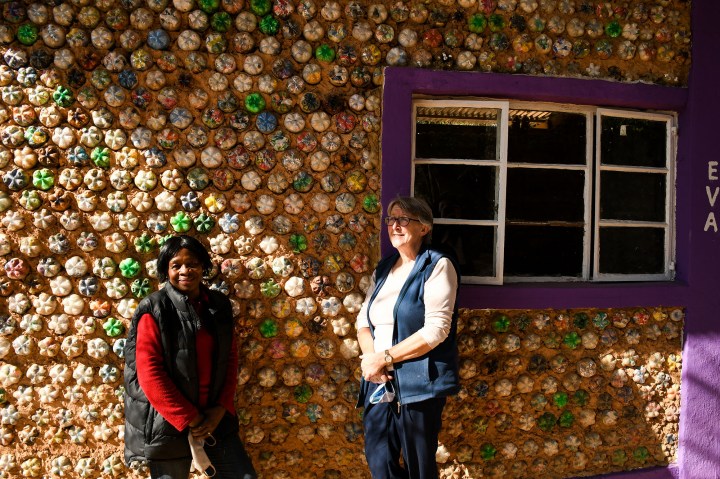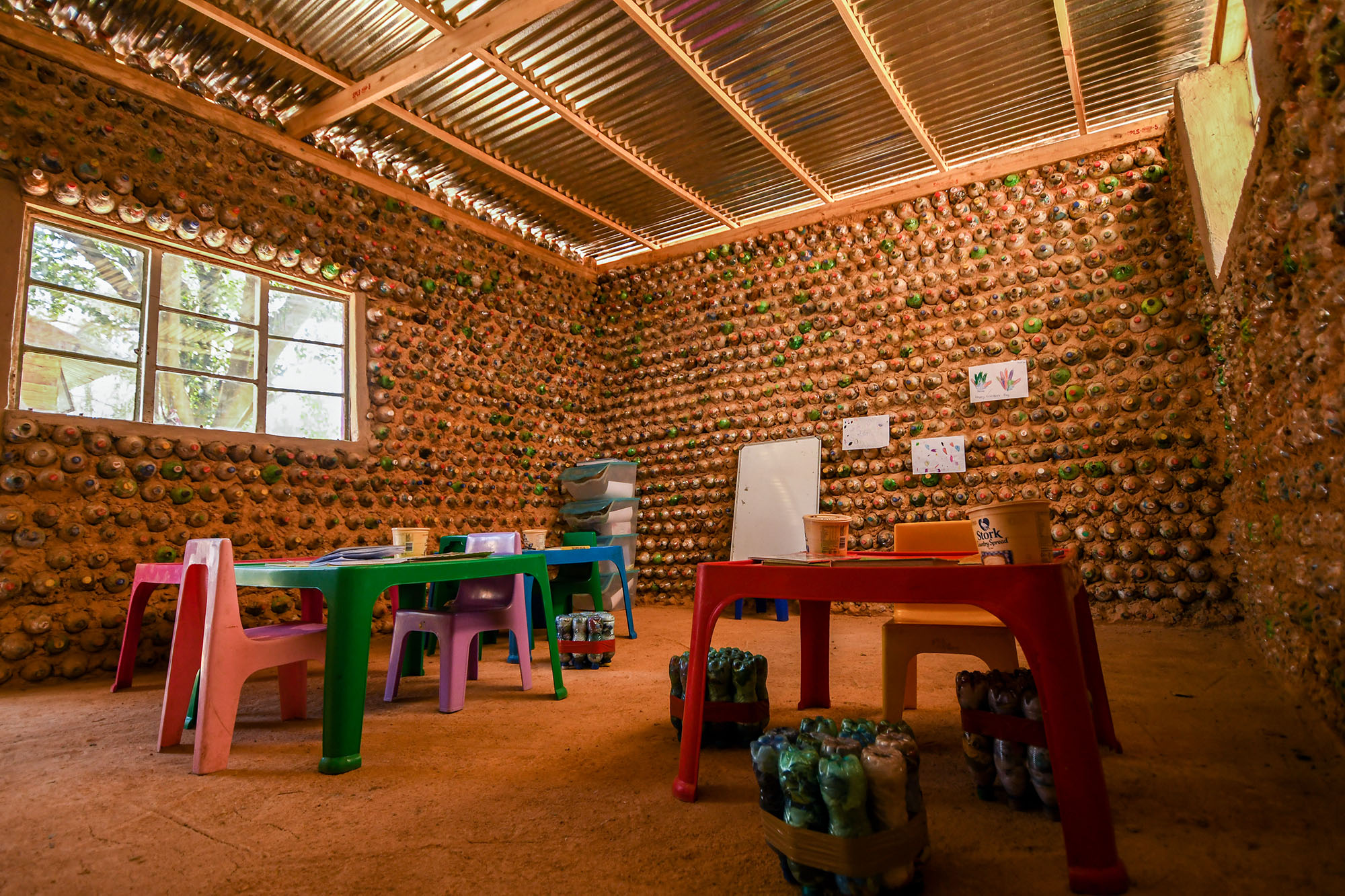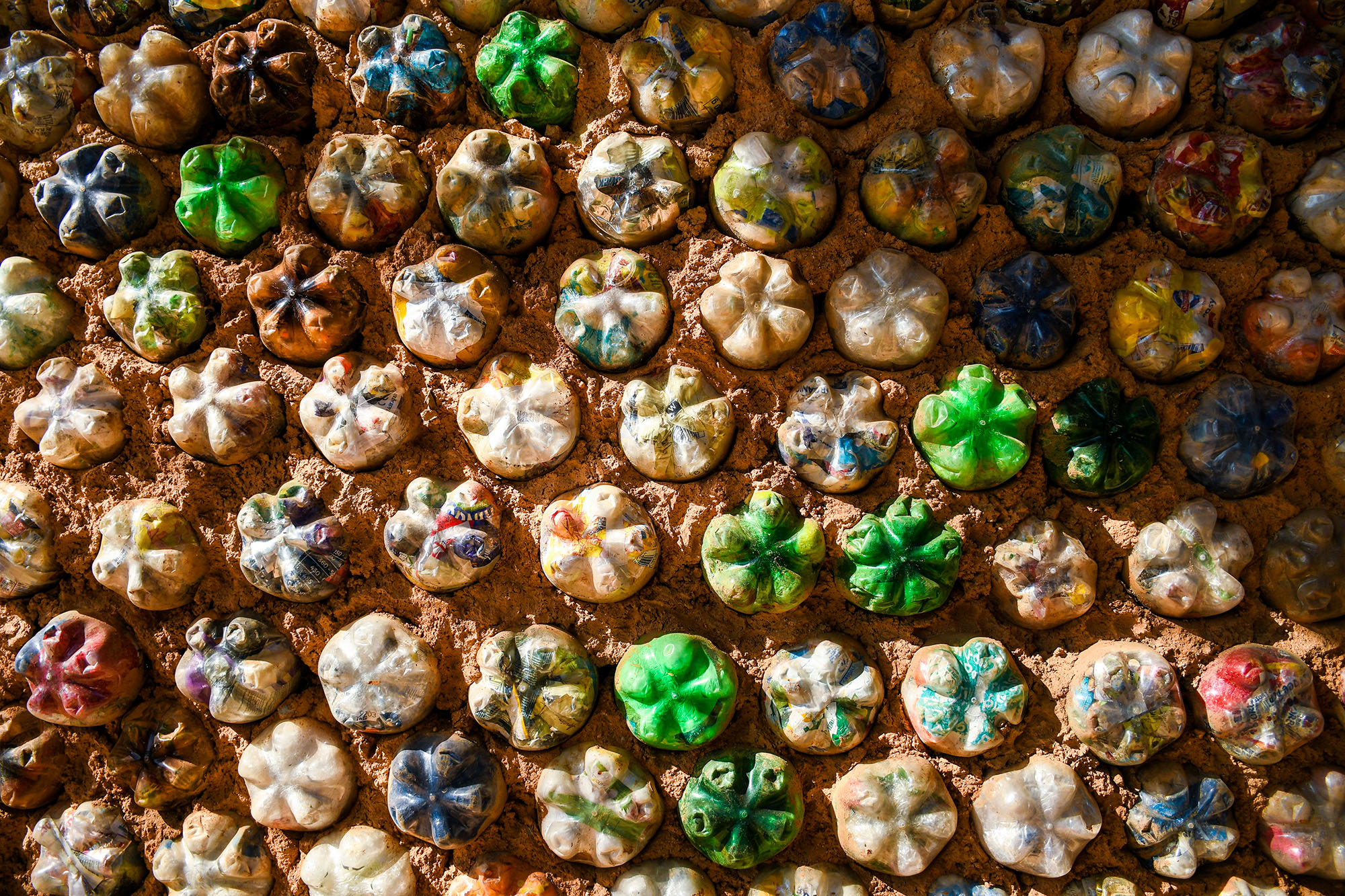OUR BURNING PLANET
Repurposing Waste: West Rand nursery school gets an ecobrick classroom made from three tonnes of non-recyclable plastic

Ecobricks are a sustainable building material and an innovative way to store tonnes of our non-recyclable plastic. However, it is not a long-term solution to the problem of single-use plastics.
Alison Griffiths wanted to build one ecobrick bench.
Fifteen benches and three years later she decided to take on the project of building a classroom for a nursery school in Muldersdrift, using ecobricks.
Griffiths, a doctor and former lecturer of physiology at Wits University, became involved with the ecobrick initiative three years ago.
Her NGO, ADVA Youth Skills Development, was involved in helping young people in Zandspruit, a township in the West Rand.

The classroom, 4m by 5m, is insulated by the ecobricks. Thoriso Nursery School principal Linda Ngoma said, ‘It is the best classroom because it’s warm.’ (Photo: Julia Evans)
“The reason I started was I was running scouts in Zandspruit, and I wanted them to do community service, but they had to do something which was free,” Griffiths told Daily Maverick.
She chose ecobricks because they were free, and after discovering people in Zandspruit don’t use much plastic, started collecting ecobricks.
“I wanted to build one bench — that was my plan, just to build one bench because… I feel like you need to do a thing right,” says Griffiths.
It takes about 300 ecobricks to build one bench. After building 15 benches at a school in the West Rand and one in her garden she wasn’t done.
“I was collecting more than I was building,” says Griffiths, “And so, I was like, we need to build something big.”

These two classrooms contain 6,000 ecobricks and 3,000 tonnes of recyclable plastic. (Photo: Julia Evans)
Sam Ngoma, a pastor in the area, told Griffiths that the nursery school he and his wife, Linda Ngoma, ran needed new classrooms.
“I’ve always wanted to build a classroom, but I’m a doctor, right, I’m not a builder. So I needed a builder. And then a builder joined our Bible study who was just as crazy as I am.”
With a builder, 20 volunteers, a collection of ecobricks and an ambitious mindset, Griffiths broke ground in January.
They built every Saturday for five months — and when they were finished had cumulatively built two classrooms, made up of 6,000 ecobricks and three tonnes of plastic that would otherwise have ended up in landfills.
Linda Ngoma, the principal of Thoriso Nursery School, said of the new classroom, “I like this one. It is the best classroom because it’s warm.”
A lot of waste
The Department of Environmental Affairs estimated in its latest and final draft of the 2018 State of Waste Report that in 2017 South Africa generated 2.2 million tonnes of plastic, 43.7% of which was recycled and 56.3% of which was landfilled.
Plastics SA, the umbrella body representing the South African plastics industry, points out that not all the plastic collected for recycling actually gets recycled.
In 2019 Plastics SA reported, “Almost three-quarters of the plastic that was recycled in South Africa during 2018 was recovered from landfills and other post-consumer sources.
“The problem with this is that these plastics are often contaminated by food and other waste materials, which makes them more expensive to process.”
This means most of the plastic we use does not get recycled, but ends up in landfills where it sits for hundreds of years, or goes into the ocean, endangering marine species.
A short-term solution for this is to pack the plastic that won’t be recycled into plastic PET bottles — to make an ecobrick.
Ecobricks: an innovative storage solution
Ecobricks are an insulative and sustainable building material and are made by tightly packing clean and dry plastics into a PET bottle.
Waste management expert Candice Mostert, the founder and director of Waste-ED, told Daily Maverick that ecobricks were first used in South Africa in 2012, but globally have been around for more than 20 years.
In terms of how long ecobricks last, Mostert said, “You don’t want them to be exposed… directly to sunlight — within a year that bottle’s brittle.”
To protect the ecobricks, Mostert suggests covering all the walls with cob — a natural building material composed of clay, sand, straw and water.
The north-facing wall of the ecobrick classroom, which is exposed to the most sunlight, was plastered over to protect the ecobricks from degradation. The other walls are exposed, but have shade from the overhanging roof.

The north-facing wall that is exposed to the most amount of sunlight, was plastered over to protect the ecobricks from degrading. (Photo: Julia Evans)
“So… you could plaster all the walls… you just need the money to do that,” said Griffiths, “so that was the major issue for us.”
The ecobricks were free, but the cost of the building materials (such as cement), the window frames, door frames, the roof and poles cost R15,000 per classroom, which all came from Griffiths’ NGO. And a plasterer was paid to plaster the north-facing wall.
“We’ve also got young men that we have trained on how to build,” said Griffiths.
“So for us it’s an employment thing as well. There’s lots of people who know construction, young guys… who have no jobs. And so if we had limitless money, we’d be building.”
Griffiths said the structure is solid. The roof is attached to the cement floor with poles, it’s “not being held up by the bricks — so structurally this is sound”.

Children at Thoriso Nursery School sit on an ecobrick bench. (Photo: Julia Evans)
About 20 people assisted with the actual building process, while hundreds helped by making an ecobrick.
Waste-ED’s Mostert sees ecobricks as a tool for education, rather than a long-term solution for storing all our “non-recyclable” plastic.
“This is all new, you know, it’s not like there was any funding or any structure in place when we started ecobricks in South Africa. We [at Waste-ED] were just passionate people saying, this is a great education tool,” Mostert said.
“So it became quite interesting after four years to realise that, hey, you know, the big message here needs to be that this is a temporary solution. And that we need to use this to set goals and to phase out materials. So that’s pretty much my programme. It’s not just, make some ecobricks and donate it, this is a process to start my journey to zero waste.”

Ecobricks are an insulative and sustainable building material and might be a short-term solution to where we can store our non-recyclable plastics. (Photo: Julia Evans)
Mostert says that making an ecobrick is a great way for consumers to become aware of plastic pollution.
“Because, as I’m stuffing, I’m connecting with my waste. You’re questioning, you’re figuring out what these materials are, you’re cleaning that packaging, and you’re finding alternatives.
“And that’s what we need to change — these kinds of habits of just throwing in the bin.”
Griffiths says, “If you start looking at your house, and all the plastic that you use… just by accident — and if you shop at the shops that we shop at, ie, Woolies and Spar, you’ll realise everything is in plastic.”
So which plastics are non-recyclable?
Well… that depends.
It depends on which country you’re in, and who your recycler is.
According to a report released in 2020 by the World Wide Fund for Nature (WWF) South Africa, most plastics can be recycled, it just depends on the recycler’s infrastructure and technology.
Mostert said that in South Africa, because there isn’t one government recycling system, “we have different private recyclers running their own businesses. And based on the facilities that they have and the demand that they have in their local communities, that kind of decides whether they’re going to be able to recycle it or not.”

In 2017, South Africa generated 2.2 million tonnes of plastic, most of which ends up in landfills. (Photo: Julia Evans)
However, mixed plastics are non-recyclable in South Africa.
“Multilayer materials made up of more than one type of plastic… are not recycled in South Africa due to economic implications and technical difficulties in separating the layers. Multilayer materials are often represented by material identification code (MIC) 7,” WWF said in its report.
You can find out what type of plastic a material is by looking at its resin or MIC code on the back.
According to the Waste-ED website, “In South Africa you will find that most mixed layer products are not recyclable, eg, chip packets, sweet wrappers, stickers etc, and so often even recyclable materials don’t make it for recycling, eg, straws, bottle tops, fruit and veg carrier bags etc. Dirty items, whether recyclable or not, will be landfilled unless the facility has a washing process.”
Mostert emphasised the need to “contact your recycler, phone them, ask them which resin code they do and do not process. That’s where the conversation starts. That’s when you get to know more.”

Resin codes can be found at the back of nearly all plastic products. They will help you determine whether you can recycle that plastic. (Graphic: Supplied)
She always divides her waste into three: food waste, recyclables and non-recyclables (based on her recycler, it’s resin 3, 6 and 7).
As for Griffiths and the Ngomas, there are many more nursery schools in the West Rand that need their help.
With funding, they plan to build 90 more structures.
“I just got sucked into it,” said Griffiths. “Like, I could leave now. If I died now I’d go, I’m cool, because I’ve done my part.
“But we’ll carry on building because I love building. Every Saturday, we wake up and we go, ah I want to stay in bed. But we get out here and we start building and we have so much fun. There’s so much enjoyment in being outside and building something and creating a legacy.” DM/OBP



















A heartwarming win:win story. Thanks for writing it.
Disappointed that the DM is helping to promote plastic on behalf of the industry. Since US plastic waste was banned by China, there’s been a rapid and apparently sponsored set of initiatives in Africa to recycle plastic for building blocks, inevitably for unemployed women and poor children. Why is this NOT win-win? Because plastic is toxic stuff, as it breaks down to micro particles in the sun (unless plastered at rather a high cost), it releases deadly fumes when it burns, and is endocrine disrupting. So accumulating more plastic around vulnerable bodies is simply unethical, no matter how nice it feels to be building a crèche. Ban plastic. And get SA to ban the import of waste.
As much as we all hate plastic and the negative impact it has on our environment. With the plastic which is flying around an open veld or park, would it not be better if for the here and now, we clean up our current environment and re-purpose the plastic and store it in an ecobrick. It takes an unbelievable amount of plastic to fill an ecobrick until it weighs the 1kg suggested. It creates an awareness for your kids to see.
I agree that the long term effect will be best to ban plastic, but now we have excess plastic and this is a good initiative to recycle, reuse and re-purpose plastic. #TideTurners #SDG
Would love to read and hear more of these type of wonderfully inspiring stories! Thank you DM – every idea executed encourages others to make a contribution: whether it’s making eco-bricks or assisting in a similar building project helping others, our society, our climate and our economy. Well done to Alison Griffiths, her NGO and the team!